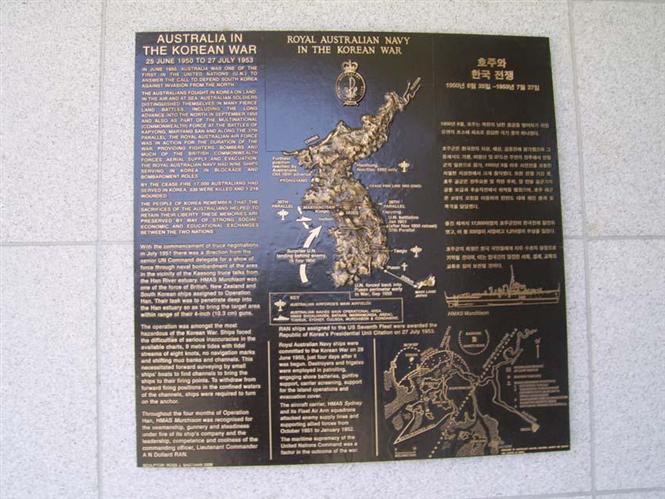Royal Australian Navy Korean War Memorial Plaque
Description
A bronze plaque mounted on a wall at the Kanghwa Visitors Centre.
History
The war in Korea began on 25 June 1950 when North Korea, under the leadership of Kim Il Sung, invaded South Korea with the aim of unifying the country under communist rule. The North Korean People’s Army were confident that the war would be a short one having a much larger army force, far superior equipment and the support of the Soviets. Initially everything went according to plan and within three days they had captured the South Korean capital of Seoul. The North Koreans and the Soviets had, however, misjudged the American reaction to the invasion and within 24 hours of the attack President Harry S. Truman decided that the United States would intervene on the side of South Korea.
On 29 June the Australian Government placed the frigate HMAS Shoalhaven and the destroyer HMAS Bataan at the disposal of General Douglas McArthur who immediately ordered both ships to join elements of the British Far East Fleet. The Shoalhaven commenced convoy escort duties while Bataan joined a task group charged with imposing a naval blockade on South Korea’s west coast. The involvement of these two ships, with some Australians also serving on exchange on British warships, heralded the beginning of a strong Australian naval contribution to the conflict. For the duration of the Korean War, the Royal Australian Navy (RAN) always maintained at least two destroyers or frigates on station employed in patrolling, engaging shore batteries, gun-fire support, carrier screening, support for island operations and evacuation cover in a threat environment from mining, air attack and counter-bombardment. In addition to threats from the enemy, their seamanship was put to the test by storms, typhoons, fast tidal currents, shifting mudflats, ice-bound waters and temperatures at and below freezing-point for long periods. Control of the seas around the peninsula by United Nations Command naval forces helped to save South Korea from total defeat in the first weeks of the war.
As well as conducting military operations, members of the RAN also provided humanitarian assistance to the general populace by making regular mercy runs to off shore islands to provide the inhabitants with food and warm clothing.
The Royal Australian Navy suffered one killed, two missing and six injured.
Australia continued to send ships to serve in Korean waters with the United Nations Command for another two years after the Armistice bought about a ceasefire on the 27 July 1953.
Total Casualties of Australian Forces: 340 died / 1,230 wounded.
For further information see: http://www.koreanroll.gov.au/history.aspx
Construction Information
The plaque was arranged by Dr Ross Bastiaan.
Location
Kanghwa Island, Korea.
The plaque is located at the entrance to the visitors centre.

